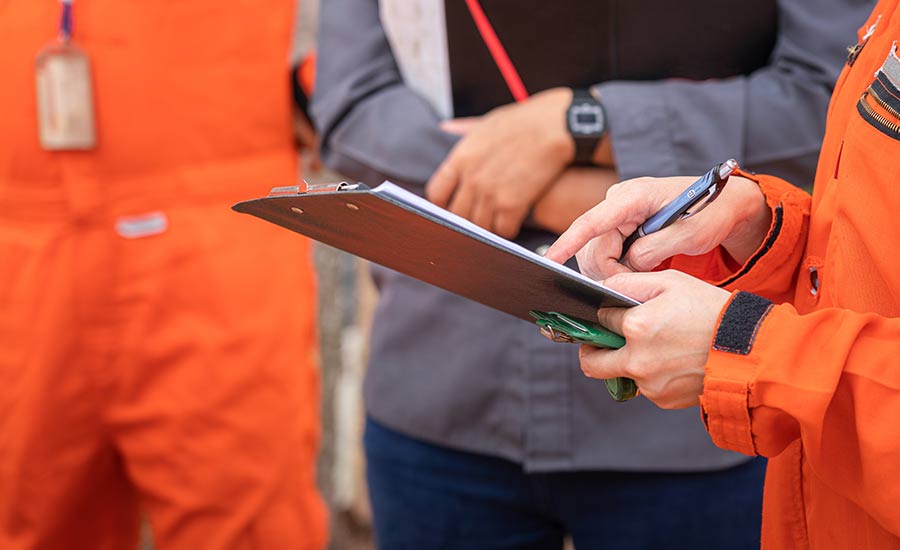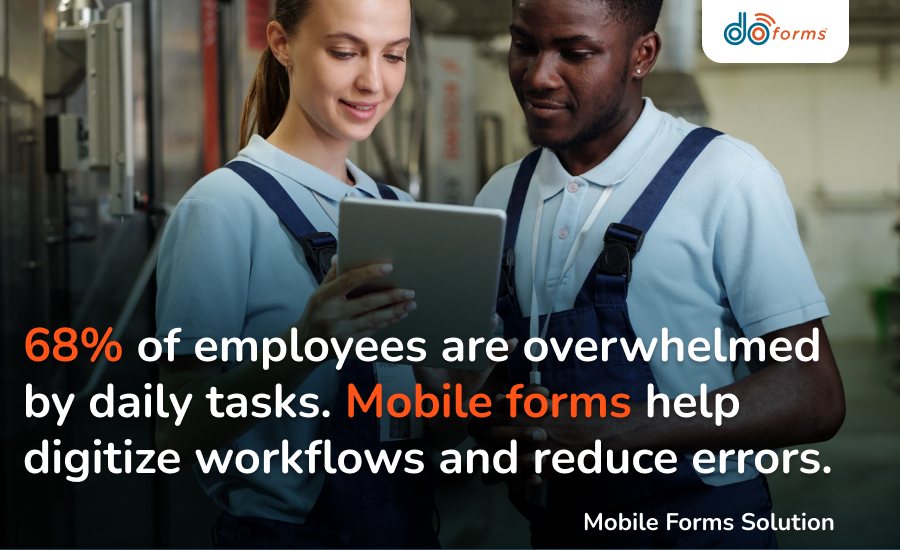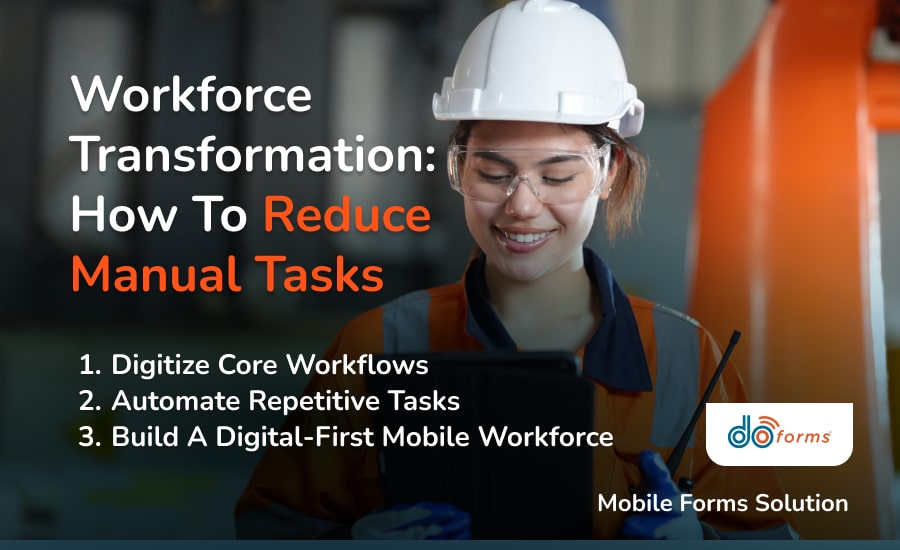
From identifying issues in workplace productivity to improving the production process and building trust among employees, a Gemba Walk is essential for managers — particularly in the manufacturing industry.
We’ll cover what a Gemba Walk checklist should include and provide a step-by-step guide to creating one. Plus, we’ll explain how to automate the process of creating a checklist, while saving time and money by using mobile forms.
Table of Contents
Interested in automating your checklists?
Try doForms for free!
What Is A Gemba Walk?
A Gemba Walk is a management method used to assess the workplace and identify problems areas. During a Gemba Walk, managers take a walking tour through the workplace and ask questions to get insights into the production process.
The term Gemba originated in the Japanese language and refers to the place where things happen in manufacturing.
The Gemba Walk concept was first introduced in the late 1980s by Taiichi Ohno, an executive at Toyota, who helped establish the Toyota Production System. This production system, also referred to as lean manufacturing, focuses on making vehicles in the quickest and most efficient way, increasing productivity and saving time.
Why Is A Gemba Walk Important?
A Gemba Walk is beneficial for improving production processes and performance. It allows you to observe processes in the workplace and engage with employees to explore opportunities for improvement.
A Gemba Walk helps in the following areas:
- Problem-solving: It provides context to a problem and helps managers understand it better, so they can come up with actionable solutions.
- Communication: Asking questions about problems and hearing answers from workers helps clarify misunderstandings and align the manager’s perspective with workers’ experiences.
- Workplace efficiency: It helps improve workplace processes, reduce waste and increase workplace productivity.
- Trust building: A manager’s presence at the workplace shows that the organization takes workplace problems and their resolution seriously, which in turn helps build trust with employees.

A Gemba Walk help you solve problems, improve communication, increase workplace efficiency and build trust
Elements Of An Effective Gemba Walk
Every successful Gemba Walk consists of a series of elements that help you identify and solve problems in the workplace. The elements of an effective Gemba Walk include:
1. Go To The Workplace
Go where work takes place. In the manufacturing industry, this is the production line. This allows you to gain valuable, firsthand insights into the workplace dynamic, observe workers in a natural setting and identify issues.
2. Ask Questions
Ask the right questions to help you identify and understand a problem. Defining the “why” helps you understand the nature of a problem and determine the cause and effect of a particular issue.
3. Treat Employees With Respect
Be available for your employees and treat them with respect. This helps build trust throughout the organization, so employees will be more open to sharing valuable information with you that can help you identify and solve a problem that may impede performance.
Planning your first Gemba Walk?
Try our mobile forms free for 30 days!
How To Plan A Gemba Walk Step-By-Step
Need to plan a Gemba Walk? We’ve compiled a simple how-to guide. Follow these 10 steps:
Step 1. Define Your Objectives
Your Gemba Walk needs to have objectives or a theme. To define the objectives for your Gemba Walk, determine your priorities.
Examples of objectives include:
- Lowering costs
- Increasing safety
- Increasing productivity
Step 2. Prepare The Team
Before going on your Gemba Walk, prepare your team by informing them when the walk will happen, explaining the topic of discussion, and sharing the benefits of the walk.
Step 3. Focus On The Process
Focus on the process, not on people or identifying problematic workers. Remember: your Gemba Walk is not an employee evaluation — it’s a productivity evaluation.
Step 4. Stick To The Value Stream
What elements of the production process are driving the most value? Analyze processes and apply valuable practices across departments. Similarly, when you notice a procedure doesn’t provide value or causes drawbacks, identify areas that can be optimized to increase value.
Step 5. Write Down Observations
Take notes about your observations throughout your Gemba Walk. Recording your findings will help you prepare a detailed report later on.
Step 6. Ask Questions
Ask precise and direct questions to gather valuable insights into the processes and potentially problematic areas. Follow the journalistic approach and ask:
- Who
- What
- When
- Where
- Why
- How
Step 7. Keep Suggestions For Later
During your Gemba Walk, you might have suggestions on how to improve processes and increase value. However, during the walk, focus on observations and take notes — save discussions and action plans for after the walk.
Step 8. Walk With Your Team
Your Gemba Walk will be more effective if you walk as a team. Invite employees to walk with you, to help point out issues or concerns you can address together.
Step 9. Keep The Schedule Flexible
You don’t need to conduct Gemba Walks on a fixed schedule, because you may run the risk of disrupting employee workflow. Instead, keep it flexible. Just make sure to announce it ahead of time. You can conduct Gemba Walks daily, once a week, once a month or as needed.
Step 10. Gather Feedback
Ask your employees for feedback, create a report and follow up regarding actionable plans for improvement.
This can be a separate meeting or you can follow up via email. Letting your employees know that their input is valued can help fortify teamwork.

A Gemba Walk consists of a series of steps, including defining your objectives, preparing the team, recording observations, asking questions and gathering feedback
Gemba Walk Checklist: Questions To Include
A crucial step in every Gemba Walk Checklist is to ask the right questions. Asking the right questions helps you derive insights and discover problematic areas and inefficiencies.
You can choose to use a standard Gemba Walk template or create a custom checklist, and tailor it according to your specific objectives.
Here are some questions to consider including in your checklist, divided into categories:
People
Questions to ask that concern workers include:
- How are you today?
- Do you understand what your priority is?
- Do you predict any obstacles that may impact your performance today?
Process
Questions to ask that concern the process may include:
- What is the objective of the process?
- Is the team applying our standard best practices?
- Have you encountered any technical issues?
- Are there any opportunities to improve the process?
Productivity
Questions to ask that concern productivity include:
- Did you encounter any challenges today or productivity issues?
- Are there any daily challenges you may be facing that impact productivity?
- Does the shift changeover cause any downtime?
- Is the equipment fully functional and set to standard? Does it require maintenance?
- Is the production rate following a set schedule?
Quality
Questions to ask that concern quality include:
- Is the product packaged according to our standards?
- Is the product labeled properly?
- Is the product ready for shipping?
Safety
Questions to ask that concern safety include:
- Have you experienced any incidents recently?
- Do you have access to personal protective equipment?
- Is the personal protective equipment suitable for the job?
- Do you have all the equipment to safely conduct the job?
Work Environment
Questions to ask that concern the work environment include:
- Does the work environment meet the set standards?
- Do you have the necessary tools for the job?
- Do workers have proper training for the job?
- Does the team need more people to perform the job?
Need to create a Gemba checklist?
Try doForms for free!
How To Create & Automate A Gemba Walk Checklist With doForms
Do you need to create a Gemba Walk checklist?
In contrast to outdated paper checklists, mobile forms provide a better, easier way to create and automate a Gemba Walk checklist. Paper checklists are time-consuming and they can cost your business up to $8,000 a year.
doForms is a mobile forms solution created to simplify time-consuming processes, such as manually creating, updating and filling out checklists. Dedicated to a paperless approach, doForms provides mobile forms solutions for:
- Data collection
- Workflow management
- Reporting
How do you benefit from doForms exactly?
doForms allows you to quickly create a Gemba Walk checklist, edit as needed, save and update as you go. You can access your Gemba Walk checklist on the go, with or without Internet access, using the doForms mobile app.
Wondering how it works? Check out the video below!
How to Build a Mobile Form with doForms | Form Builder Software
provider: youtube
url: https://www.youtube.com/watch?v=IopZakLTZ-U
src: https://www.youtube-nocookie.com/embed/IopZakLTZ-U?wmode=transparent&rel=0&feature=oembed
src mod: https://www.youtube-nocookie.com/embed/IopZakLTZ-U?wmode=transparent&rel=0
src gen: https://www.youtube-nocookie.com/embed/IopZakLTZ-U
Switching to mobile or electronic forms with doForms allows you to:
- Create a Gemba Walk checklist template
- Create custom forms for your organization
- Access, update, sign and send forms from any location
- Save money on paper costs
- Organize your forms in one centralized location
In addition to simplifying and automating the process of creating Gemba Walk checklists, doForms allows you to manage employee payroll, create reports and track inventory — all from one centralized and secure location!
To streamline operations, cut down on paper costs and automate time-consuming paper-based processes, opt for doForms paperless checklists and custom mobile forms.




